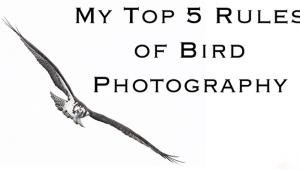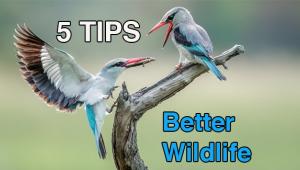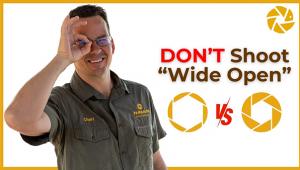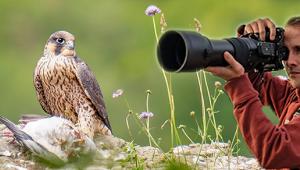Sense Of Scale, Length Of Lens: In Wildlife Photography, “Small” Can Have A Big Impact
Filing the frame with the critter isn’t required for great wildlife photography. Reflecting on how I first slanted my wildlife photography in this direction, it has its roots in the first lens I had to shoot wildlife. I started with a Vivitar 400mm f/5.6 on an old Minolta that was soon replaced with a Nikon 400mm f/5.6 on an F2. That 400mm was my main lens for a long time and it taught me lessons about wildlife photography that I still depend on to this day.
For starters, you don’t need a giant lens. You can work wonders and create great images with just an APS-C sensor D-SLR (with a multiplication factor of 1.5x or 1.6x) and a 70-300mm or 100-400mm lens. This combination puts you in the 400mm range, that is, in range of photographing any critter on this planet.
Backgrounds
You know this is an Alaskan Bull Moose and not from the Rockies or Maine because of the background (#1). It not only makes the subject pop visually it also tells a story.

The background sets the stage for that long stare over his territory as a Pronghorn buck in South Dakota takes it all in (#2). While small in the frame, you can’t but help see him and his stare.

If the subject is small, how will anyone see it in your photograph? Shooting with a 400mm focal length gives you a very narrow angle of view. It’s kind of like looking through a straw. When you move just inches left or right, up or down, you can radically change the framing, and the background. This is one of the greatest lessons the 400mm will teach you, working with backgrounds. Most photographers think about backgrounds and worry about the twig sticking out of the cranium of the subject. Use the background to not only make your subject visually pop, but also to tell the story. We are visual communicators, so think of the background as the stage and the critter as the main character in the play.
Light & Color
The last rays of light near the Arctic Ocean catch this Snowy Owl on the prowl (#3). The long shadows and warm light help tell a story of place and time.
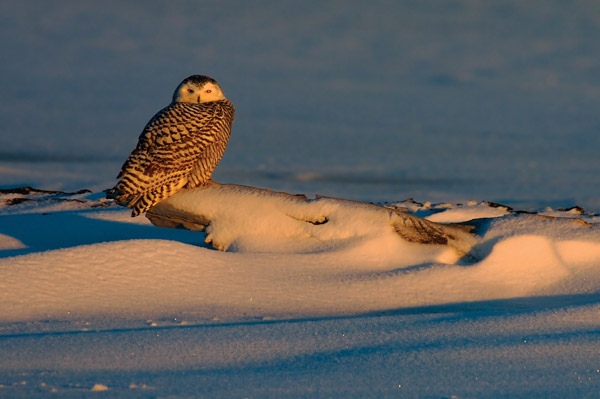
May and the calves are being dropped. Their orange coats against the spring grass, you can see them even when they are this small in the frame (#4).

What does the main character on a stage have working for them besides props? Light and color, of course. Incorporate these same elements in your viewfinder and your photographs will take off. Light is the obvious important ingredient for many reasons. The quantity and quality of light is a major storyteller in its own right. It provides visual depth, texture, shape and especially mood. Add in color, be it monochrome or great color contrast and that small critter flies off the page.
Deep Shadows
This image was shot at high noon when the shadows are their deepest. In this case they lead the eye right down to the 2 Raccoon kids checking me out (#5). Shadows are a powerful tool in wildlife photography!

The one element in all of this that tends to get over looked by wildlife photographers is the very simple color, black. Be it a color or shadow, black leads the mind’s eye to wonderful things. It gives shape, definition, texture and in the form of shadows, lets the imagination go wild. Black is a color the mind latches onto and then refers to when determining the shade of green or brown. And deep shadows can makes elements look sharper, tricking the eye to see something that in reality isn’t really there.
Depth Of Field
The Collared Pika (#6), is no bigger than a tennis ball, blending right into its talus slope world. Using a narrow DOF when it’s perched on the knife-edge of the bolder makes it pop even though it is really small in the frame.

Getting down low, opening the lens up all the way and having the background far away makes this Columbian Ground Squirrel jump off the page though small in the frame (#7).
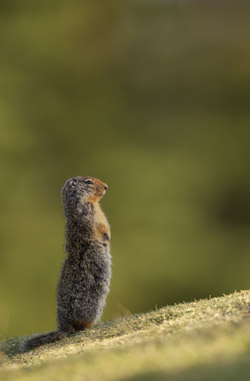
The one other important aspect of photography the telephoto can teach you about when working with a small subject is depth of field. Open up the lens and you can say this is a squirrel and it’s cute, period. The same squirrel and the same moment, but you want to say here’s a cute squirrel and it lives on this slope, you close the lens down. Take it a step further and say that squirrel lives on a slope on a big mountain and you get down low and let the magic of the telephoto do it all for you.
Putting It All Together
How do you express a cold world? Small image size, bluish tint (thanks to falling snow) and a little bit of tree convey the severity of living in the north for this Red Fox (#8).

The beauty and grace of the Bald Eagle in flight is quite something (#9). When you can capture a mating pair in spring, it’s spectacular, an aerial ballet like no other!

There will come a day when you will want more in your viewfinder. The shorter tele lens will teach you the best way possible. A subject at 60 feet with an 800mm lens will be the same size in the viewfinder as a 400mm lens at 30 feet. But getting those 30 feet closer is the challenge for most photographers, and that’s the lesson the 400mm will teach you!
Getting close physically and isolating with optics has been the hallmark of my photography from the beginning. And that came from shooting with a 400mm lens. When you start to learn basic biology, you learn how to get close. When you learn how to get close then you learn to know where to walk, when to walk and when to click to capture that great image. You want a bigger subject? Simply move and make it bigger!
Some of my favorite images, my most iconic and biggest moneymakers were made with the 400mm lens. While the 600mm is still my principle bird lens, the 400mm is still my principle big game lens. All the lessons I learned 30 years ago at the back of my first 400mm lens I still use to this day. So even though you might need a 600mm lens some day as your involvement with wildlife photography grows, you can have a lot of success and fun starting out with the 70-300mm or 100-400mm. It’s all up to you, the photographer behind the camera, to make the small have big impact.
Get It Steady
Proper handholding: lens cradled in the left hand, elbows tucked, camera pulled back is essential for sharp images. This is the extreme with Jake shooting out of a HU-16 Albatross in the slip stream (#10).

Whatever the focal length, a key to sharp images is learning to keep the lens steady. One of the beautiful things about “shorter” telephotos is their portability, being able to shoot handheld. As you increase the focal length, any movement at the camera is magnified, which makes getting a sharp image even more challenging. Taking a sharp image requires a solid handholding technique. This is what you need to practice over and over again—cup your left hand and have the lens barrel rest in it. Bring your elbows into your sides and tuck the camera up into your face by using a rubber eye cup (it acts like a shock absorber). Grasp the camera body with your right hand and rest your finger on the shutter release and then roll your finger to fire the camera.
How do you practice? If you can’t squeeze off just one frame with the camera set to continuous, sit at night with the camera in your lap until you can. If you can’t handhold the rig and get a sharp image of an object with a shutter speed of 1/30, practice until you can.
Why worry about shooting at such a slow shutter speed when you can just raise the ISO? This is a very valid question and the only answer I can honestly provide is that I shoot at ISOs in the basement to maintain the quality level.
About the author: Moose’s true passion has always been photographing the life history of our endangered wildlife and wild places. Since 1981 he and his wife Sharon have dedicated their lives to this pursuit. Educating the public about our wild heritage is their hallmark. Along the way Moose has been honored for his photographic passion: a Nikon Legend Behind the Lens, Lexar Elite Photographer, recipient of the John Muir Conservation Award, Research Associate with the Endangered Species Recovery Program, just to name a few. He shares his knowledge through his writing, being published in over 131 magazines worldwide, author of 24 books including his latest, “Captured: Lessons From Behind The Lens Of A Legendary Wildlife Photographer”, and lecturing across the country to thousands of photographers. Moose continues being a creative innovator of new techniques both behind the camera and the computer, which is the driving force behind his photography and goals.
- Log in or register to post comments






